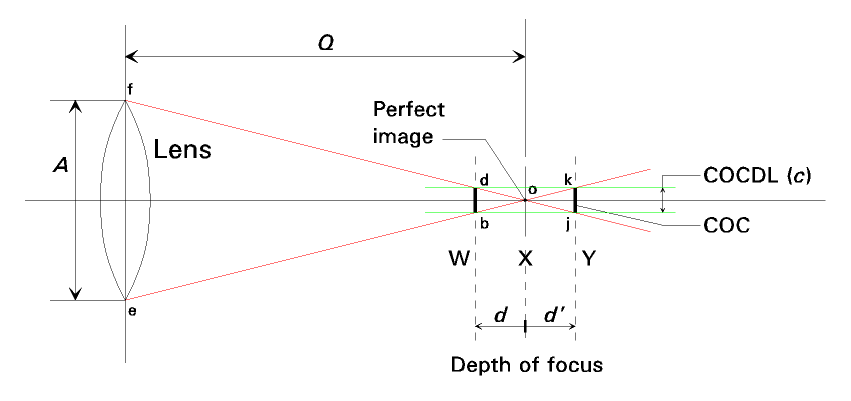Doug Kerr
Well-known member
Depth of focus is a concept similar to depth of field. In depth of field, we ask the question:
• With the camera focused at a certain distance, over what range of distances to an object will a point on the object be imaged as a blur figure (circle of confusion) whose diameter is not greater than some arbitrary value we select, the circle of confusion diameter limit (COCDL).
In depth of focus, we ask the question:
• With the camera focused at a certain distance, over what range of distances to the film will a point on the object be imaged as a blur figure (circle of confusion) whose diameter is not greater than some arbitrary value we select, the circle of confusion diameter limit (COCDL).
Derivation of the fundamental equation for depth of focus is actually simpler than for depth of field.
We can follow the action on this figure:

The red lines represent two rays from a point on the object, the outermost rays that can me admitted by the aperture of our lens (shown here as a "thin lens"). The focus setting is that they converge at point a; if the film is at a plane, X, through that point, a perfect "point" image is formed.
We have adopted a value c, of the COCDL to be our criterion for "acceptable" blurring from imperfect focus. The green lines represent the limits on the diameter of the circle of confusion (COC) for that COCDL.
Thus we see that a COC of that limiting diameter would result for the film at either plane W or Y. The thick lines represent the blur figures.
Consider the case of the film at plane W, a limiting location. We have two similar triangles, o-b-d and o-e-f.
Thus, we can see that this obtains:
where c is the COCDL; d is the distance from X, the plane of perfect focus, to W, the plane at which the blur figure of diameter c occurs; Q is the distance from the lens to the plane of perfect focus, X; and A is the diameter of the lens aperture.
From the focus equation and the definition of magnification, it can be shown that:
Note also that the f number of the lens, N, is given by:
where f is the focal length of the lens.
Putting this all together, we get:
This then gives us the single-sided depth of focus in the "forward" direction.
Now triangle o-j-k is congruent to triangle o-b-d. Thus the calculations regarding the limiting blur figure at plane Y are the same as we just saw, giving:
where d' is the single-sided depth of focus in the "rearward" direction.
Accordingly, we can state the depth of focus as:
(using d to mean both d and d').
The "double-sided" depth of focus, d'', can be given as:
Best regards,
Doug
• With the camera focused at a certain distance, over what range of distances to an object will a point on the object be imaged as a blur figure (circle of confusion) whose diameter is not greater than some arbitrary value we select, the circle of confusion diameter limit (COCDL).
In depth of focus, we ask the question:
• With the camera focused at a certain distance, over what range of distances to the film will a point on the object be imaged as a blur figure (circle of confusion) whose diameter is not greater than some arbitrary value we select, the circle of confusion diameter limit (COCDL).
Derivation of the fundamental equation for depth of focus is actually simpler than for depth of field.
We can follow the action on this figure:

The red lines represent two rays from a point on the object, the outermost rays that can me admitted by the aperture of our lens (shown here as a "thin lens"). The focus setting is that they converge at point a; if the film is at a plane, X, through that point, a perfect "point" image is formed.
We have adopted a value c, of the COCDL to be our criterion for "acceptable" blurring from imperfect focus. The green lines represent the limits on the diameter of the circle of confusion (COC) for that COCDL.
Thus we see that a COC of that limiting diameter would result for the film at either plane W or Y. The thick lines represent the blur figures.
Consider the case of the film at plane W, a limiting location. We have two similar triangles, o-b-d and o-e-f.
Thus, we can see that this obtains:
c/d = Q/A
where c is the COCDL; d is the distance from X, the plane of perfect focus, to W, the plane at which the blur figure of diameter c occurs; Q is the distance from the lens to the plane of perfect focus, X; and A is the diameter of the lens aperture.
From the focus equation and the definition of magnification, it can be shown that:
Q=(1+m)f
Note also that the f number of the lens, N, is given by:
N=f/A
where f is the focal length of the lens.
Putting this all together, we get:
d=(1+m) c N
This then gives us the single-sided depth of focus in the "forward" direction.
Now triangle o-j-k is congruent to triangle o-b-d. Thus the calculations regarding the limiting blur figure at plane Y are the same as we just saw, giving:
d'=(1+m) c N
where d' is the single-sided depth of focus in the "rearward" direction.
Accordingly, we can state the depth of focus as:
d=±(1+m) c N
(using d to mean both d and d').
The "double-sided" depth of focus, d'', can be given as:
d''=2 (1+m) c N
Best regards,
Doug
